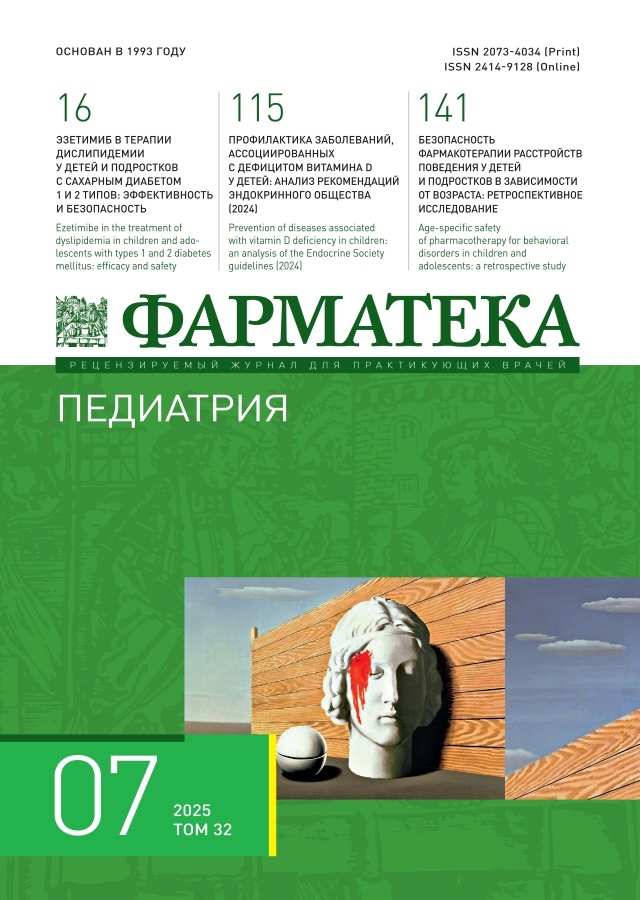Experience with selumetinib in a patient with neurofibromatosis type 1 and inoperable pelvic plexiform neurofibroma: a case report
- Autores: Donyush E.K.1, Zhironkina A.B.1
-
Afiliações:
- Russian Children’s Clinical Hospital – Branch of the Pirogov Russian National Research Medical University
- Edição: Volume 32, Nº 7 (2025)
- Páginas: 157-162
- Seção: Clinical case
- URL: https://journals.eco-vector.com/2073-4034/article/view/693758
- DOI: https://doi.org/10.18565/pharmateca.2025.7.157-162
- ID: 693758
Citar
Texto integral
Resumo
Neurofibromatosis type 1 (NF1) is a multisystem genetic disorder with tumor syndrome associated with mutations in the NF1 gene. It manifests early in life and progresses throughout life. Plexiform neurofibromas (PN) are present in 30–50% of patients with NF1. They cause nerve dysfunction and bone destruction, impede normal growth and development in the affected area, and lead to chronic pain and significant cosmetic defects. Surgical removal of pelvic NF can be associated with a high risk of death, frequent postoperative recurrences, and in some cases, is impossible. Selumetinib, an oral, highly selective MEK1/2 inhibitor, was approved by the FDA in 2020 and registered in Russia in 2021 for monotherapy for symptomatic, inoperable PN in pediatric patients with NF1 over 3 years of age. It can reduce the volume or stabilize the growth of PN, reduce the incidence of internal organ complications, and significantly improve patients’ quality of life. This publication presents a clinical case of a patient with inoperable pelvic PN who received targeted therapy with selumetinib, which resulted in a positive outcome.
Palavras-chave
Texto integral
Sobre autores
E. Donyush
Russian Children’s Clinical Hospital – Branch of the Pirogov Russian National Research Medical University
Autor responsável pela correspondência
Email: donyush_e_k@rdkb.ru
ORCID ID: 0000-0002-4252-8829
Cand. Sci. (Med.), Associate Professor, Head of the Hematology and Chemotherapy Department No. 3
Rússia, MoscowA. Zhironkina
Russian Children’s Clinical Hospital – Branch of the Pirogov Russian National Research Medical University
Email: zhironkina_anna00@mail.ru
ORCID ID: 0009-0006-9342-5527
Hematologist, Hematology and Chemotherapy Department No. 3
Rússia, MoscowBibliografia
- Blakeley J., Plotkin S. Therapeutic advances for the tumors associated with neurofibromatosis type 1, type 2, and schwannomatosis. Neuro Oncology. 2016;18:624–38. https://dx.doi.org/10.1093/neuonc/nov200
- Yap Y.S., McPherson J.R., Ong C.K., et al. The NF1 gene revisited – from bench to bedside. Oncotarget. 2014;5:5873–92. https://dx.doi.org/10.18632/oncotarget.2194
- Gutmann D.H., Ferner R.E., Listernick R.H., et al. Neurofibromatosis type 1. Nat Rev Dis Prim. 2017;3:1–17. https://dx.doi.org/10.1038/nrdp.2017.4
- Farschtschi S., Mautner V.-F., Lawson McLean A.C., et al. The neurofibromatoses. Deutsches Ärzteblatt International. 2020;117(20):354. https://dx.doi.org/10.3238/arztebl.2020.0354
- Cimino P.J., Gutmann D.H. Neurofibromatosis type 1. Handbook of clinical neurology. 2018;148:799–811. https://dx.doi.org/10.1016/b978-0-444-64076-5.00051-x
- Miller D., et al., Health Supervision for Children with Neurofibromatosis Type 1. Pediatrics. 2019;143(5):e20190660. https://dx.doi.org/10.1542/peds.2019-0660
- Hirbe A., Guttman D. Neurofi bromatosis type 1: a multidisciplinary approach to care. Lancet. Neurol. 2014;13:834–43. doi: 10.1016/S1474-4422(14)70063-8
- Tonsgard J. Clinical manifestations and management of neurofibromatosis type 1. Semin Pediatr Neurol. 2006;13:2–7. https://dx.doi.org/10.1016/j.spen.2006.01.005
- Friedman J.M. Neurofibromatosis 1. 1998 Oct 2 [Updated 2022 Apr 21]. In: Adam M.P., Mirzaa G.M., Pagon R.A., et al., ed. GeneReviews® [Internet]. Seattle (WA): University of Washington, Seattle; 1993–2022.
- Hersh J., American Academy of Pediatrics Committee on Genetics. Health supervision for children with neurofibromatosis. Pedaitrics 2008;121:633–42.
- Reilly K., et al. Neurofibromatosis Type 1-Associated MPNST State of the Science: Outlining a Research Agenda for the Future. J Natl Cancer Inst. 2017;109(8):djx124. https://dx.doi.org/10.1093/jnci/djx124
- Farid M., et al. Malignant peripheral nerve sheath tumors. Oncologist. 2014;19:193–201. https://dx.doi.org/10.1634/theoncologist.2013-0328
- Yuan Z.N., Xu L.B., Zhao Z.G., et al. Clinicopathological features and prognosis of malignant peripheral nerve sheath tumor: a retrospective study of 159 cases from 1999 to 2016. Oncotarget (2017) 8:104785–95. doi: 10.18632/oncotarget.18975
- Karwacki M.W., et al. Coordinated medical care for children with neurofibromatosis type 1 and related RASopathies in Poland. Arch Med Sci. 2021;17(5):1221–31. https://dx.doi.org/10.5114/aoms.2019.85143
- Peltonen S., et al. Pediatric malignancies in neurofibromatosis type 1: A population-based cohort study. Int J Cancer. 2019;145(11):2926–32. https://dx.doi.org/10.1002/ijc.32187
- Needle M.N., Cnaan A., Dattilo J. et al. Prognostic signs in the surgical management of plexiform neurofibroma: The Children’s Hospital of Philadelphia experience, 1974–1994. J Pediatr 1997;131:678–82. https://dx.doi.org/10.1016/s0022-3476(97)70092-1
- Nguyen R., et al. Growth behavior of plexiform neurofibromas after surgery. Genet Med. 2013;15:691–7. https://dx.doi.org/10.1038/gim.2013.30
- Prada C.E., Rangwala F.A., Martin L.J., et al. Pediatric plexiform neurofibromas: impact on morbidity and mortality in neurofibromatosis type 1. J Pediatr. 2012;160(3):461–7. https://dx.doi.org/10.1016/j.jpeds.2011.08.051
- Общая характеристика лекарственного препарата Коселуго® (капсулы, 10 мг, 25 мг). Регистрационное удостоверение ЛП-№ (005053)-(РГ-RU) от 31.07.2025. [General characteristics of the medicinal product Koselugo® (capsules, 10 mg, 25 mg). Registration certificate LP-No. (005053)-(RG-RU) dated July 31, 2025. (In Russ.)].
- Gross A.M., et al. Selumetinib in children with inoperable plexiform neurofibromas. New Engl J Med. 2020;382(15):1430–42. https://dx.doi.org/10.1056/nejmoa1912735
- Gross A.M. et al. Long-term safety and efficacy of selumetinib in children with neurofibromatosis type 1 on a phase 1/2 trial for inoperable plexiform neurofibromas. Neuro Oncology. 2023;25(10):1883–1894. https://dx.doi.org/10.1093/neuonc/noad086
Arquivos suplementares












